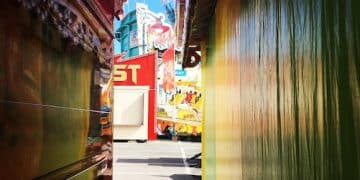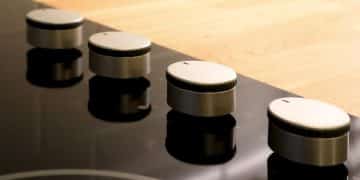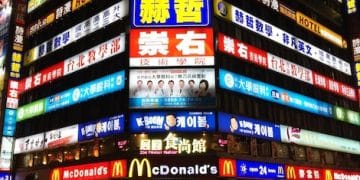Maximize Your Yen: Insider Tax-Free Shopping in Japan for US Residents
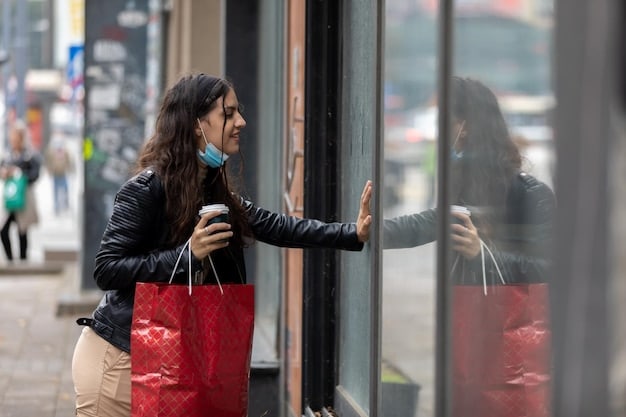
Navigating tax-free shopping in Japan as a US resident offers significant savings, provided you understand the eligibility criteria, required documentation, and the strategic locations to maximize your purchases, efficiently extending your travel budget.
For US residents traveling to Japan, the prospect of indulging in its unique shopping scene is incredibly exciting. From cutting-edge electronics to traditional crafts and fashion, Japan offers an unparalleled retail experience. However, to truly
Understanding Japan’s Tax-Free System for Tourists
Japan’s tax-free shopping program is designed to incentivize foreign visitors to spend more by allowing them to reclaim the consumption tax (currently 10%) on eligible purchases. This system is a significant advantage for tourists, enabling them to enjoy luxury goods, electronics, cosmetics, and even certain consumable items at a reduced price. Eligibility is primarily based on your non-resident status and the duration of your stay.
The process often involves presenting your passport at a designated tax-free counter within participating stores. It’s crucial to understand that not all stores offer tax-free shopping, and among those that do, there might be specific departments or transaction minimums that apply. Shoppers need to be vigilant about spotting the “Tax-Free” sign, usually prominently displayed at storefronts or cash registers. This sign is your primary indicator that savings are possible. The system is straightforward once you know the rules, but overlooking a small detail can lead to missing out on the savings. Preparing beforehand by knowing what to look for can significantly enhance your shopping experience.
Who is Eligible for Tax-Free Shopping?
Eligibility for tax-free shopping in Japan is primarily for non-residents. This typically means individuals holding a temporary visitor visa, which is generally issued to tourists.
- Temporary Visitor Status: Ensure your passport is stamped with a “Temporary Visitor” seal upon entry. This is the cornerstone of your eligibility.
- Duration of Stay: Generally, you must be staying in Japan for less than six months. Long-term residents or those on certain types of visas are not eligible.
- Passport Requirement: Your physical passport must be presented at the time of purchase. Copies or digital images are usually not accepted.
It’s worth noting that Japanese nationals residing overseas for more than two years are also eligible upon their temporary return to Japan, provided they present their overseas residence proof. However, for most US tourists, focusing on the temporary visitor status and passport requirements will cover their needs. The system is designed to be accessible but requires adherence to these basic rules.
Types of Goods Eligible for Tax Exemption
Japan categorizes tax-free goods into two main types: general goods and consumable goods. Understanding the distinction is vital, as different rules and minimum spending thresholds apply.
- General Goods: This category includes items like electronics, clothing, shoes, bags, jewelry, and home appliances. The minimum purchase amount for general goods to be tax-free is usually 5,000 JPY (excluding tax) at a single store on the same day. These items can be used in Japan and do not need to be sealed.
- Consumable Goods: This covers food, beverages (non-alcoholic), cosmetics, medicines, and tobacco. For these items to be tax-free, the total purchase amount must also be between 5,000 JPY and 500,000 JPY (excluding tax) at a single store on the same day. Consumable goods must be sealed in special transparent bags and cannot be opened until you leave Japan. Breaking the seal before departure can invalidate the tax exemption.
Some stores might combine generals and consumables for the 5,000 JPY minimum, but this is less common. Always ask the staff if you’re unsure. The regulations are strict to prevent misuse, so adhering to them ensures a smooth process. Knowing which items fall into which category allows for more strategic shopping, especially when trying to meet the minimum spending thresholds.
The core concept is to verify your eligibility and understand the item categories. Without a valid temporary visitor stamp and your physical passport, tax-free shopping cannot proceed. Furthermore, being aware of the general goods versus consumable goods distinction helps you plan your purchases and avoid surprises at the tax-free counter. Always look for the tax-free sign, commonly depicted as a silhouette of Japan with a shopping bag or the words “Tax-Free” in English. This visual cue simplifies the search for participating merchants and streamlines your shopping experience.
Moreover, it’s essential to understand that while the system is designed to benefit tourists, the responsibility for adhering to the rules lies with the shopper. Misunderstandings can lead to lost savings. Therefore, asking store clerks for clarification if you’re uncertain about a particular item or the process is always a good idea. Many larger department stores and popular shopping districts have staff accustomed to assisting international visitors with tax-free purchases, making the experience more accessible.
Navigating the Tax-Free Shopping Process
The tax-free shopping process in Japan is generally efficient, but familiarity with its steps can save time and prevent potential headaches. From finding the right shops to completing the necessary paperwork, each stage plays a crucial role in securing your savings. Understanding this flow means you can focus more on enjoying your purchases and less on procedural details.
Identifying Tax-Free Stores and Retailers
Recognizing where you can shop tax-free is the first step towards maximizing your savings. Japan has a robust network of tax-free shops, ranging from large department stores to smaller specialty boutiques.
- Official Signage: Look for the prominent “Tax-Free” logo, often displayed in English and Japanese, found at store entrances, windows, or near cash registers. This is the official indicator.
- Tourist Information Centers: These centers often provide lists or maps of tax-free shops in their respective areas, which can be invaluable for planning your shopping routes.
- Major Department Stores: Most large department stores (e.g., Isetan, Mitsukoshi, Daimaru, Takashimaya, Bic Camera, Yamada Denki) offer tax-free services, often with dedicated tax-free counters.
Smaller, independent shops might not participate in the tax-free program due to administrative complexities, so it’s always best to check for the sign or inquire with staff. Some online retailers also offer tax-free options for international shipping, but this usually involves different procedures than in-store purchases.
Required Documentation and Purchase Steps
Having the correct documents ready streamline the tax-free process. The presentation of these items at the point of sale is non-negotiable.
- Physical Passport: Your original passport with the “Temporary Visitor” stamp proof is essential. Digital copies or photos will not be accepted.
- Purchase Receipts: Keep all your receipts for eligible tax-free purchases. These will be necessary for processing the refund.
- Credit Card (if applicable): If you paid by credit card, ensure the name on the card matches the name on your passport.
The steps for purchasing are typically as follows:
1. Shop and Spend: Accumulate purchases that meet the minimum spending threshold for either general or consumable goods.
2. Present Passport: At the designated tax-free counter (or main cash register in smaller stores), present your passport.
3. Fill Out Forms: You may need to fill out a simple form detailing your purchases and personal information.
4. Receive Refund: The refund is usually processed directly at the store, meaning you pay the tax-exempt price upfront or receive an immediate cash refund. In some cases, especially at airports, you might pay the full price and receive a refund later.
5. Seal Consumables: If purchasing consumable goods, they will be sealed in a special transparent bag. Do not open this bag until you have left Japan.
Understanding these steps in advance simplifies the process, making your shopping more efficient. Many stores have English-speaking staff or clear instructions to assist international visitors, further easing the process. Remembering the physical passport requirement is perhaps the most critical tip, as forgetting it can mean missing out on savings.
Furthermore, it’s beneficial to consolidate your purchases at one large store or department that offers tax-free services. This makes it easier to meet the minimum spending thresholds and streamlines the refund process, as you’ll only deal with one counter. Major department stores are particularly adept at handling tax-free transactions, often providing dedicated foreign visitor service centers that can assist with language barriers and complex queries.
Another insider tip is to save time by looking for duty-free shops at airports. While these shops are already tax-exempt by nature, they often have a more limited selection compared to city-based stores. However, for last-minute purchases or unique airport-exclusive items, they can be a convenient option. The key distinction is that tax-free shopping involves a refund of the consumption tax, while duty-free shopping means you never pay duties or taxes in the first place, typically at international airports.
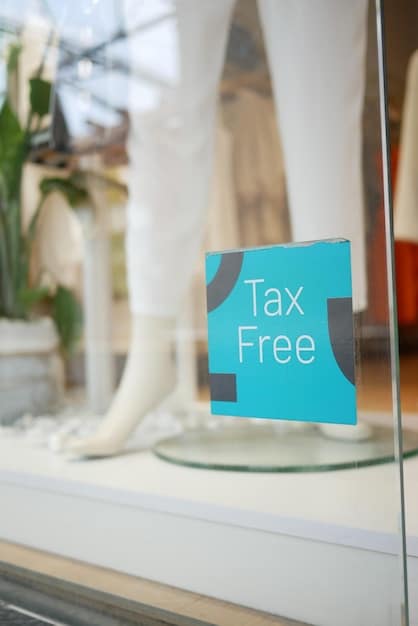
Common Pitfalls and How to Avoid Them
While Japan’s tax-free shopping system is generally user-friendly, there are common mistakes that can lead to missed savings or complications. Being aware of these pitfalls and how to avoid them is crucial for a smooth and satisfying shopping experience. Preparation and attention to detail can make all the difference.
Misunderstanding Consumable vs. General Goods Rules
One of the most frequent misunderstandings revolves around the distinct rules for consumable and general goods. Failing to differentiate can lead to issues at customs or invalidate your tax exemption.
- Breaking the Seal: For consumable goods (food, cosmetics, medicine), the most critical rule is NOT to open the sealed bag until you’ve left Japan. Customs officials may check this. If the seal is broken, you might be required to pay the consumption tax.
- Usage Restrictions: General goods (clothing, electronics) can be used while you are in Japan. There are no restrictions on their usage before departure.
- Combined Purchases: While some stores allow combining general and consumable goods to meet the 5,000 JPY minimum, this is not universal. Always clarify if you plan to mix categories to ensure eligibility.
When in doubt, treat all tax-free purchases, especially consumables, with care. The clear, sealed bags are designed to signal these items to customs, and maintaining their integrity is paramount.
Forgetting Your Passport or Losing Receipts
The physical passport is the lifeline of tax-free shopping. Without it, stores cannot process your tax exemption. Similarly, misplaced receipts can complicate matters for refund processing.
- Always Carry Your Physical Passport: A digital photo or a copy is insufficient. You need the original document with your “Temporary Visitor” stamp. Make it a habit to carry it, especially on shopping days.
- Keep All Receipts Organized: Store your tax-free receipts in a dedicated envelope or folder. Some stores staple the receipt directly into your passport, but always double-check.
- Timely Processing: Tax-free purchases must be processed at the time of purchase in most cases. You cannot typically go back to a store days later to claim a refund for past purchases.
A simple routine of checking for your passport before leaving your hotel and immediately securing your receipts after a purchase can prevent these frustrating scenarios. Losing a physical passport while abroad can also generate a whole host of other issues outside of tax-free shopping.
Overlooking Minimum Purchase Amounts and Store Policies
Each tax-free transaction requires adherence to minimum purchase thresholds. Overlooking these or not understanding specific store policies can result in paying the full price.
- 5,000 JPY Minimum: Remember the 5,000 JPY (excluding tax) threshold per store, per day, for both general and consumable goods.
- Single Store Rule: The minimum must often be met within a single store, not across multiple branches of the same chain, unless specified.
- Specific Store Counters: Large department stores often have a dedicated tax refund counter, usually on a specific floor. Go there directly after all your purchases within that store are complete. Some smaller shops process refunds directly at the main cash register.
It’s always wise to ask: “Do you offer tax-free shopping?” or “Can I get a tax refund here?” if the signage isn’t clear. Staff are generally helpful and can direct you to the correct counter or explain the specific procedures. Being proactive in asking questions ensures you meet all the requirements and avoid any disappointments.
Another frequently underestimated pitfall is the sheer volume of paper. Each tax-free transaction generates a small slip that is stapled into your passport. While this serves as a record, it can quickly accumulate. Before leaving Japan, these slips are typically collected by customs. Some travelers find it helpful to keep a small, dedicated section of their passport free for these slips to avoid clutter and ensure they are not accidentally removed.
Finally, be mindful of currency conversion rates if refunds are offered in a currency other than JPY, or if you’re using a foreign credit card. While the tax exemption saves you 10%, unfavorable exchange rates or foreign transaction fees from your bank could slightly eat into those savings. Paying in JPY and receiving the refund in JPY is usually the most straightforward way to avoid these secondary costs.
Maximizing Your Shopping Experience Beyond Tax-Free
While tax-free savings are a significant draw, a truly optimized shopping experience in Japan extends beyond merely reclaiming tax. It involves strategic planning, understanding local shopping nuances, and leveraging various payment methods and discounts. Integrating these elements can further enhance your value and enjoyment.
Strategic Shopping Locations and Timing
Where and when you shop can greatly influence your overall experience and the availability of deals. Japan offers a diverse range of shopping districts, each with its own character.
- Major City Hubs: Tokyo (Shibuya, Shinjuku, Ginza, Akihabara), Osaka (Dotonbori, Umeda), and Kyoto (Kawaramachi, Gion) are prime locations with a high concentration of tax-free eligible stores.
- Department Store Sales: Keep an eye out for seasonal sales. January (New Year’s fukubukuro/lucky bags) and July (summer sales) are particularly good times for discounts in department stores.
- Electronics Districts: Akihabara in Tokyo and Den Den Town in Osaka are meccas for electronics, often featuring competitive prices and dedicated tax-free counters.
Shopping during off-peak hours can also provide a more relaxed experience, as popular areas can become extremely crowded. Early mornings or late evenings just before closing are often less busy.
Utilizing Credit Cards and Foreign Exchange
Payment methods and currency exchange strategies can impact your final spending. Being smart about how you pay can lead to additional savings.
- Credit Card Benefits: Use a credit card with no foreign transaction fees. Many travel-focused credit cards offer this perk, which can save you 1-3% on every purchase.
- Dynamic Currency Conversion (DCC): When offered the choice to pay in USD or JPY, always choose JPY. DCC allows the merchant to convert your purchase to your home currency, often at an unfavorable exchange rate. Paying in JPY ensures your bank applies its (hopefully better) exchange rate.
- ATMs for Cash: While many places accept cards, smaller shops or restaurants may prefer cash. ATMs at 7-Eleven stores or Japan Post Offices are reliable for withdrawing JPY using international debit/credit cards.
Being mindful of these financial aspects adds another layer of savings and convenience to your shopping trips. Planning cash withdrawals based on your spending habits can also prevent unnecessary fees.
Beyond the financial considerations, immersing yourself in Japan’s shopping culture enriches the experience. For instance, exploring local markets like Nishiki Market in Kyoto offers a glimpse into traditional Japanese food and artisan goods, many of which can also be tax-free. Similarly, unique shopping streets like Takeshita Street in Harajuku (Tokyo) cater to specific niches, providing one-of-a-kind finds.
Another strategic approach is to combine shopping with cultural exploration. Many temples, museums, and historical sites have well-stocked gift shops offering high-quality souvenirs that might also be tax-free. This allows you to purchase keepsakes directly from the source, often with a unique story or local craftsmanship, while still benefiting from the tax exemption. It transforms shopping from a standalone activity into an integrated part of your travel itinerary.
Handling Your Tax-Free Purchases Upon Departure
The final step in the tax-free process occurs at the airport. Proper handling of your purchases at departure ensures you fully realize your savings and avoid potential issues.
* Keep Items Accessible: Have your tax-free goods, especially consumables in their sealed bags, easily accessible. Customs officials may ask to inspect them upon departure.
* Tax-Exemption Slip Collection: At the airport, usually before security, there will be a customs counter where you turn in the tax-free slips stapled to your passport. Follow the signs for “Customs” or “Tax Refund.”
* Don’t Pack Consumables in Checked Baggage: If you plan to check your luggage, remember that consumable tax-free goods must be carried with you until you leave Japan. Therefore, they should be in your carry-on or easily accessible hand luggage for inspection. General goods can be packed in checked luggage.
* Arrive Early: Allow ample time at the airport for this process, especially during peak travel seasons, as queues can form.
Leveraging Digital Tools and Apps
Technology can further simplify your tax-free shopping journey. Several apps and websites are designed to assist tourists.
- Japan Official Tax-Free App: The Japan Tourism Agency often provides an official app or website listing tax-free stores and current regulations.
- Translation Apps: For smaller shops where English might be less common, a translation app can be invaluable for clarifying tax-free policies or product details.
- Currency Converters: While not directly related to tax-free, a reliable currency converter app can help you quickly calculate the actual cost of items in USD.
These digital aids help bridge potential language barriers and provide real-time information, making your shopping more informed and efficient. Checking these resources before and during your trip can save time and effort.
Beyond the Yen: Cultural Considerations in Japanese Shopping
Shopping in Japan isn’t just about transactions; it’s an immersive cultural experience that can enrich your travel memories. Understanding certain cultural nuances can enhance your interactions and appreciation for Japanese retail.
The Art of Japanese Service (Omotenashi)
Omotenashi, the unique Japanese approach to hospitality, is evident in every aspect of the retail experience. It’s a selfless dedication to anticipating and fulfilling the needs of guests without expectation of reward.
- Politeness and Respect: Expect exceptionally polite and attentive service. Store staff will typically greet you warmly, assist patiently, and often walk you to the door upon departure.
- Presentation Matters: Goods are often immaculately presented, and packaging is an art form. Even small purchases might come wrapped beautifully.
- Attention to Detail: From neatly folded clothes to impeccably arranged displays, Japanese retailers excel in meticulousness, contributing to a pleasant shopping environment.
Embracing this spirit of service can transform a simple shopping trip into a memorable cultural interaction. A simple “arigato gozaimasu” (thank you very much) goes a long way in acknowledging their efforts.
Unique Japanese Shopping Habits and Etiquette
Navigating shops with an awareness of local etiquette can ensure a respectful and positive experience.
- No Tipping: Tipping is not customary in Japan and can sometimes be seen as rude. The service charge is usually included in the price.
- Bagging Purchases: Many stores will carefully bag your purchases. It’s common to receive a small plastic bag for each item, or a larger bag for all items.
- Quiet Demeanor: While not a strict rule, Japanese shoppers tend to be more reserved. Keeping noise levels down, especially on crowded shopping streets, is appreciated.
These subtle differences contribute to Japan’s unique retail atmosphere. Respecting them shows appreciation for the local culture.
Furthermore, be aware of the “kawaii” (cute) culture that pervades many aspects of Japanese shopping, especially in areas like Harajuku. Even everyday items can be adorned with charming characters or designs, reflecting Japan’s playful aesthetic. This extends to fashion, stationery, and even food items, offering a delightful contrast to more traditional goods.
Consider also the seasonal aspect of Japanese retail. Each season brings unique products, from cherry blossom-themed goods in spring to autumn leaf-inspired items. Limited-edition seasonal releases are common for snacks, cosmetics, and various merchandise, making each visit a potentially new discovery. Keeping an eye on these special releases can lead to truly unique finds that go beyond the usual tourist souvenirs.
Finally, exploring shopping centers attached to major train stations, such as Tokyo Station’s Daimaru or Kyoto Station’s Isetan, can be particularly efficient. These tend to have a wide array of stores, including tax-free options, and are easily accessible via public transport. They also often house a variety of restaurants, allowing for a combined shopping and dining experience within a single complex, maximizing your time and convenience.
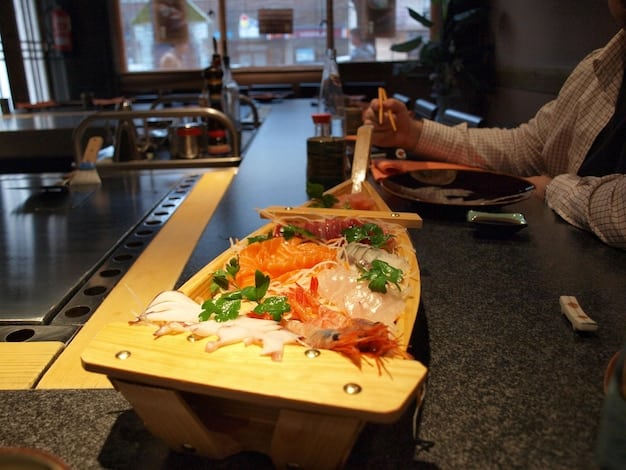
Special Considerations for US Residents
As a US resident, there are specific aspects of international travel and shopping that apply to you, particularly concerning customs and import regulations when returning home. Being informed about these can prevent unexpected duties or issues upon re-entry.
US Customs and Import Regulations
Upon returning to the US, you are required to declare all items acquired abroad. This is an important step that should not be overlooked.
- Personal Exemption Limits: US citizens and residents generally have a personal exemption limit for goods brought back from overseas without paying duty. This limit is currently $800 for most international travel.
- Cumulative Purchases: All items purchased, whether tax-free or not, count towards this exemption. Keep a running tally of your spending.
- Items Over Exemption: If your total purchases exceed the $800 limit, you will be required to pay duty on the excess amount. Duty rates vary depending on the item.
It’s advisable to keep your receipts readily available for US Customs and Border Protection (CBP) officers and be honest about your purchases. Attempting to under-declare or conceal items can lead to penalties.
Electronics and Warranties
Purchasing electronics in Japan can offer significant savings, but there are important considerations regarding warranties and compatibility.
- Voltage Compatibility: Japan uses 100V, while the US uses 120V. Most modern electronics are dual-voltage, but always check the product specifications to ensure compatibility and that you won’t need a voltage converter.
- Plug Type: Japan uses the same Type A and B plugs as the US, so adapters are generally not an issue.
- International Warranties: Many electronics purchased in Japan may not have international warranties that are valid in the US. This means you might need to send the item back to Japan for repairs or pay for repairs domestically if issues arise. Always inquire about warranty coverage if it’s a significant concern.
- Language Settings: While most modern electronics offer multiple language options, some Japan-specific models might have limited language support for menus or voice commands.
For high-value electronics, weighing the savings against potential warranty issues and language barriers is crucial. Sometimes, the peace of mind of buying locally with a US warranty outweighs the immediate tax-free savings.
Regarding personal exemptions, consider compiling a list of your purchases with estimated values. This simplifies the declaration process at US customs. Packing high-value items where they are easily accessible for inspection can also speed up your re-entry. It demonstrates transparency and readiness to comply with regulations, often leading to a smoother experience.
For consumables, especially food items, be mindful of US import restrictions. While you save tax in Japan, some items might be subject to agricultural restrictions or quantity limits upon entry into the US. For example, certain meats, fresh produce, and unpasteurized dairy products may be prohibited. CBP provides detailed guidelines, and a quick check of their website before packing your souvenir snacks can prevent items from being confiscated.
Finally, remember that the temporary visitor status that grants you tax-free eligibility in Japan is for tourist purposes. Ensure your activities align with this status. While extensive shopping is part of tourism, engaging in activities strictly for commercial resale purposes can lead to issues with both Japanese customs upon departure and US customs upon re-entry. Always ensure your purchases are for personal consumption or gifting.
| Key Point | Brief Description |
|---|---|
| 🛂 Eligibility | US residents with “Temporary Visitor” status can claim tax refunds on eligible purchases. |
| 🛍️ Product Categories | 分為 General 5,000 JPY+ (used freely) and Consumable 5,000-500,000 JPY (sealed until departure). |
| 📜 Documentation | Always carry your physical passport; save all tax-free receipts for processing and US customs. |
| ✈️ Departure Process | Present sealed consumables and tax slips at customs before departing Japan. Declare items upon US re-entry. |
Frequently Asked Questions About Tax-Free Shopping in Japan
Yes, you can use general tax-free goods like clothing or electronics while in Japan. However, consumable goods such as food, cosmetics, or medicines must remain unopened in their sealed tax-free bags until you depart the country. Breaking the seal before departure may incur sales tax upon inspection.
For both general and consumable goods, the minimum purchase amount to qualify for tax-free shopping is 5,000 JPY (excluding tax) at a single store on the same day. Consumable goods have an upper limit of 500,000 JPY (excluding tax) per person per day.
In most participating stores, the refund is processed immediately at a dedicated tax-free counter, meaning you pay the tax-exempt price upfront. Some smaller shops might process it at the main cash register. At the airport, you’ll typically just hand over the tax-free slips attached to your passport at customs.
If you forget your physical passport, you will not be able to claim a tax refund. Japanese retailers require the original passport with your “Temporary Visitor” stamp to process tax-free purchases. Digital copies or photos of your passport are not accepted as valid documentation.
No, not all stores offer tax-free shopping. Only stores that are officially registered as “tax-free shops” participate in the program. Look for the prominent “Tax-Free” sign displayed at store entrances or at their cash registers. Major department stores and popular tourist shopping areas are more likely to have this service.
Conclusion
Navigating tax-free shopping in Japan as a US resident offers a rewarding opportunity to enhance your travel budget and bring back more of Japan’s unique treasures. By understanding the eligibility requirements, differentiating between general and consumable goods, having your original passport ready, and being aware of US customs regulations, you can seamlessly integrate tax savings into your shopping adventures. Beyond the financial benefits, embracing the local shopping culture and strategic planning will undoubtedly enrich your overall experience, ensuring your trip to Japan is as cost-effective as it is memorable.
